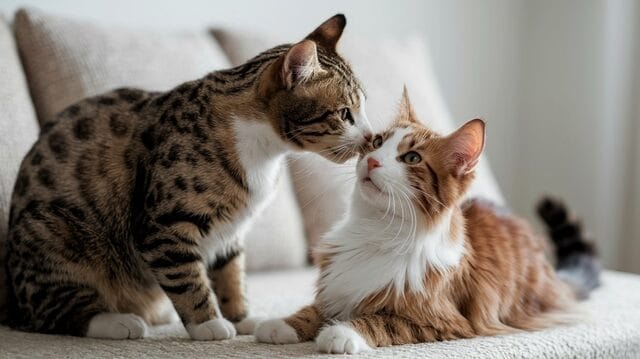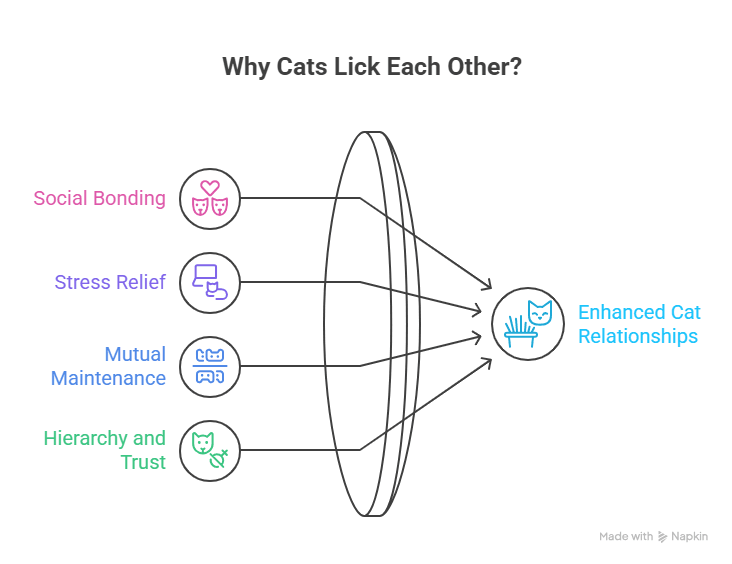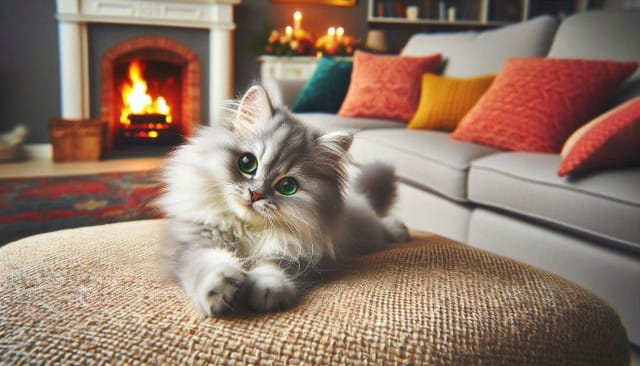
Introduction
One minute, your cats are curled up together in what looks like a moment of pure love, grooming each other affectionately. The next minute? Swatting, chasing, hissing, and wrestling like it’s WrestleMania.
What just happened?!
It’s a moment nearly every cat parent has witnessed, and it leaves many scratching their heads:
“Why do cats lick each other then fight?”
Are they bonding? Are they annoyed? Are they secretly feuding?
The truth is, this behavior—though confusing—is totally normal. In this article, we’ll unpack the science and psychology behind this odd feline habit. By the end, you’ll know how to tell the difference between affection, play, and conflict, and how to support healthier social dynamics between your cats.
What Is Allogrooming? (AKA Mutual Grooming in Cats)
To understand this behavior, we have to start with a fancy word: allogrooming.
Allogrooming is when animals groom each other as a social activity. In cats, it’s most common between:
- Siblings from the same litter
- Mother cats and kittens
- Cats in bonded pairs or stable multi-cat households
Allogrooming is more than hygiene—it’s a display of trust, bonding, and even status. It mimics early kittenhood, when a mother licked her kittens to clean and comfort them.
When adult cats groom each other, they’re saying:
“I trust you. We’re family. You’re in my group.”
But that doesn’t mean it’s always peaceful.
Why Cats Lick Each Other: The Sweet Side of the Story

Before we get to the fighting, let’s talk about the love.
Here’s why your cats might be licking each other:
🧼 1. Social Bonding
Licking reinforces bonds. It’s like giving a hug or handshake in human terms. This is especially true for cats that sleep together, share resources, or grew up together.
😌 2. Stress Relief
Grooming is soothing for cats. When they groom each other, it lowers cortisol and strengthens the feeling of security.
🐾 3. Mutual Maintenance
Some areas—like the back of the head and neck—are hard to reach. Cats help each other out by grooming the places they can’t get to.
👑 4. Hierarchy and Trust
Sometimes the cat doing the grooming is asserting gentle dominance. Other times, it’s a sign of submission. Either way, it’s part of a complex social structure.
So if you see your cats licking each other, that’s a good sign. It means they feel safe enough to share personal space.
So Why Does It Suddenly Turn Into a Fight?
Here’s where it gets weird. One moment they’re besties, the next they’re biting or tackling each other. This change is sudden, but it’s not necessarily aggression.
Let’s explore the reasons behind this bizarre switch.
🔄 1. Overstimulation
Yes, even grooming can be too much.
Cats have highly sensitive nerve endings, especially around the head and neck. While grooming might start off pleasantly, prolonged contact can lead to sensory overload.
Signs of overstimulation:
- Flicking tail
- Tense muscles
- Flattened ears
- Skin twitching
- Sudden growl or swat
This often looks like affection turning into a fight—but really, it’s one cat saying:
“Okay, that’s enough now.”
🧠 2. Miscommunication
Cats use body language to signal “I’m done” or “Back off.” If one cat ignores those signals, the other might escalate to biting or chasing.
It’s not a fight out of hate—it’s a misunderstanding.
Just like how a playful tap on the shoulder between people can turn annoying if it goes on too long, cats have boundaries too.
🐈⬛ 3. Dominance Assertion
Sometimes, grooming is about power.
The cat doing the licking is often subtly asserting control. This can build up tension, especially if the receiving cat is more dominant or independent.
What looks like a sweet moment might actually be:
“I’m the boss—deal with it.”
“Oh really? Let’s see about that.”
Boom—play fight (or real fight) begins.
🧨 4. Redirected Aggression
If a cat is already irritated—say from a noise, window trigger, or another pet—they might redirect that frustration during grooming.
The grooming cat might just be in the wrong place at the wrong time.
This behavior is common in multi-cat homes or when outdoor stressors (like strange cats, birds, or dogs) are nearby.
Are My Cats Fighting or Just Playing? Here’s How to Tell
It’s essential to distinguish between real aggression and roughhousing.
Cats play-fight all the time, especially if they’re young or high-energy. But how do you know what’s safe and what’s not?
✅ Signs of Playful Grooming → Wrestling:
- Takes turns being on top
- No hissing or growling
- Claws usually retracted
- Chasing followed by stopping
- Breaks in between “bouts”
- No one hiding afterward
🚨 Signs of Real Aggression:
- Hissing, growling, or yowling
- Flattened ears, puffed tail
- Ears pinned back
- Claws out and swatting to hurt
- One cat hides, avoids the other
- Injuries or fur pulled out
If you’re unsure, observe the aftermath:
Do they go back to sleeping near each other, or avoid each other for hours?
Should You Intervene When Grooming Turns into Fighting?
Sometimes yes. Sometimes no.
❌ Don’t intervene if:
- There’s no yowling, growling, or injury
- They separate naturally
- They return to calm behavior quickly
✅ Do intervene if:
- It escalates to true aggression
- One cat hides consistently afterward
- You notice wounds or avoidance behavior
- It happens daily or multiple times a day
How to intervene:
- Stay calm. Never yell or punish.
- Distract with a toy or loud sound from another room
- Give them space to cool down
- Redirect their energy through play
Avoid picking up either cat during the conflict—it could lead to redirected aggression toward you.
How to Support Healthy Grooming and Social Behavior
If your cats groom each other but sometimes fight, that’s okay. You can still set them up for better interactions.
🛋️ 1. Provide Plenty of Space
Make sure each cat has:
- Their own bed or perch
- Separate food bowls
- Multiple litter boxes (rule: 1 per cat + 1 extra)
🧸 2. Create Enrichment Opportunities
Cats that play together, stay together.
Use:
- Puzzle feeders
- Wand toys
- Vertical climbing shelves
- Window perches
🧘 3. Watch for Personality Differences
Some cats are more social. Others are independent. Respect their boundaries and let relationships develop at their pace.
💧 4. Use Calming Aids if Needed
Consider:
- Feliway diffusers (mimics calming pheromones)
- Interactive feeders to distract from stress
- Routine vet check-ups to rule out health issues that cause irritability
When to Be Concerned About Cat Fights
Occasional grooming-to-fighting transitions are normal. But in some cases, it may indicate a deeper issue.
Contact your vet or a feline behaviorist if:
- Your cats were bonded but now fight regularly
- One cat is getting injured or losing weight
- You’ve added a new cat or pet recently
- There’s litter box avoidance or inappropriate peeing
- You suspect pain or illness (arthritis, dental disease, etc.)
Sudden behavior changes are always worth investigating.
FAQs
Is it normal for cats to lick and then suddenly bite?
Yes. This is often caused by overstimulation or playfulness. The bite is usually gentle and a way to communicate “I’m done.”
Why does one of my cats always do the licking?
That cat may be more dominant or maternal. It’s often a sign of affection and control, both at once.
Should I separate my cats after they fight post-grooming?
Only if the conflict escalates to aggression, if they calm down on their own, let them reset naturally.
Can grooming fights damage their bond?
Usually no. Grooming and mock fighting are part of normal feline social behavior. Persistent aggression is the real concern.
Also Read - How to Keep Your Cat's Teeth Clean Without Brushing?
Conclusion
So, why do cats lick each other then fight?
Because cats are complex creatures. What looks like mixed signals is actually a blend of:
- Social bonding
- Communication
- Overstimulation
- And sometimes, asserting dominance
This behavior is usually not something to worry about. It’s how cats manage relationships, set boundaries, and stay connected—all without using words.
As long as there’s no real aggression, let them be. Monitor their body language, provide space and enrichment, and enjoy the quirky dynamics of multi-cat life.
After all, in the feline world, a little roughhousing is just part of love. 🐾💛





Cats are such fascinating creatures with their complex social behaviors. It’s amazing how grooming can signify trust and bonding, yet it can also lead to playful or even tense moments. Understanding the difference between affection and conflict is key to ensuring a harmonious environment for them. I wonder, how can we as pet owners better interpret these behaviors to support our cats’ relationships?
Great question! Observing their interactions in short sessions and learning each cat’s personal limits is key. If grooming turns into aggression, it often means one cat has had enough, so gently redirecting them with toys or treats can help avoid tension. How many cats do you have at home?